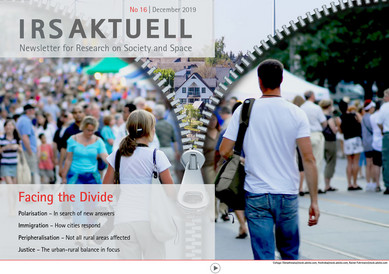Main Content
Facing the Divide
No 16 | December 2019

That social disparity is on the rise in our society is largely no longer a matter of dispute. Many analyses and studies even speak of social polarisation, meaning that opposition is increasing while the centre ground is being lost. This social divergence is also spatially evident. Whether it be within urban neighbourhoods or between city and countryside, inequalities are becoming more pronounced. The IRS researches socio-spatial polarisation from a variety of perspectives and, through policy consultation, assists in the search for possibilities for restoring balance. This themed issue examines both of these aspects.
Social polarisation forms in relation to inequalities in income and the unequal distribution of wealth, through the division of the labour market into sectors according to qualifications and income, or through segmentation of the housing market into different areas by price and supply. A new line of social polarisation can currently also be discerned in the handling of migration: while cosmopolitan, urban academics and business representatives espouse a liberal-minded immigration society and the controlled immigration of qualified workers, among the rather sedentary segments of the population threatened by decline in many rural spaces there is a strengthening of xenophobic and right-wing populist positions that advocate for the limitation or discontinuation of international migration. Out of this polarisation, new social conflicts are currently arising in structurally weak cities, for which no political solutions have yet been found. The contribution to the recently completed lead project of the research department “Regeneration of Cities and Towns” expands upon the topic of migration and polarisation.
Polarisation takes place at various levels. On the one hand a new opposition between “metropolis” and “province” is appearing between urban and rural spaces. At the same time, social segregation and displacement continues to advance within individual neighbourhoods in large cities. In their research, the department “Regeneration of Cities and Towns” has thus far focused on the concepts of peripheralisation and marginalisation with regard to socio-spatial processes of decline. Small and medium-sized cities and regions at the rural periphery are becoming isolated, as populations decline and age due to the emigration of its qualified workforce, the closure of infrastructure such as schools and railway stations, and their increasing dependence on decision-making centres in economy and politics.. Within cities their arises a growing concentration of low-income households in “problem areas”, which are often characterised by poor spatial location, substandard infrastructure, and qualitatively poorer housing stock. Such areas are often so-called “arrival neighbourhoods”, i.e. districts that become the target areas of migrants and which must therefore make arrival and integration possible, while simultaneously managing the challenges of newly introduced diversity.
These forms of socio-spatial inequality have been researched for decades and are regularly described in spatial-development reports and the federal government’s reports on poverty and wealth. For a long time, spatial policies in Germany have, coming from a liberal-market perspective, paid little attention to the increasing spatial inequality. Only since the rise of the right-wing populist AfD in the most recent municipal, state, and national elections has the equality of living conditions anchored in the German constitution been rediscovered by politics, leading to a search for ways in which “neglected spaces” and spaces in which many people feel subjectively abandoned can once again be more strongly integrated into the economic and political system. To this end, the Federal Ministry of the Interior has employed a new commission for “Equal living conditions” in building and housing, which should submit concrete suggestions next year for the support of these regions.

